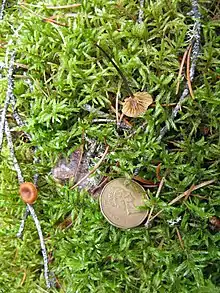| Entoloma mammosum | |
|---|---|
 | |
| Gill detail | |
| Scientific classification | |
| Kingdom: | |
| Division: | |
| Class: | |
| Order: | |
| Family: | |
| Genus: | |
| Species: | E. mammosum |
| Binomial name | |
| Entoloma mammosum | |
| Synonyms[1] | |
Entoloma mammosum, commonly known as the bell-shaped Nolanea, is a species of fungus in the family Entolomataceae. The fruit bodies are small and nippled, with a striate cap, salmon-colored gills, and a stately stalk. It is typically found growing in feather moss under spruce and Jack pine in the summer and fall. It is saprobic, and derives nutrients from rotting organic matter.[2] The fungus was originally described by Carl Linnaeus in 1753 as Agaricus mammosus. American mycologist Lexemuel Ray Hesler transferred it to Entoloma in 1967.[1]
References
- 1 2 "GSD Species Synonymy: Entoloma mammosum (L.) Hesler". Species Fungorum. CAB International. Retrieved 2014-01-29.
- ↑ Bossenmaier, Eugene F. (1997). Mushrooms of the Boreal Forest. University Extension Press, University of Saskatchewan. ISBN 978-0-88880-355-9.
This article is issued from Wikipedia. The text is licensed under Creative Commons - Attribution - Sharealike. Additional terms may apply for the media files.